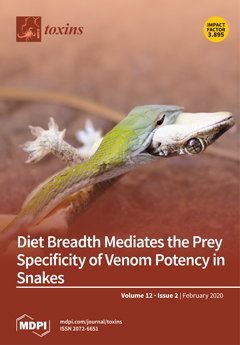In the last decade, several outbreaks of ciguatera fish poisoning (CFP) have been reported in the Canary Islands (central northeast Atlantic Ocean), confirming ciguatera as an emerging alimentary risk in this region. Five
Gambierdiscus species,
G. australes,
G. excentricus,
G. silvae,
G. carolinianus and
G. caribaeus, have been detected in macrophytes from this area and are known to produce the ciguatoxins (CTXs) that cause CFP. A characterization of the toxicity of these species is the first step in identifying locations in the Canary Islands at risk of CFP. Therefore, in this study the toxicity of 63 strains of these five
Gambierdiscus species were analysed using the erythrocyte lysis assay to evaluate their maitotoxin (MTX) content. In addition, 20 of the strains were also analysed in a neuroblastoma Neuro-2a (N2a) cytotoxicity assay to determine their CTX-like toxicity. The results allowed the different species to be grouped according to their ratios of CTX-like and MTX-like toxicity. MTX-like toxicity was especially high in
G. excentricus and
G. australes but much lower in the other species and lowest in
G. silvae. CTX-like toxicity was highest in
G. excentricus, which produced the toxin in amounts ranging between 128.2 ± 25.68 and 510.6 ± 134.2 fg CTX1B equivalents (eq) cell
−1 (mean ± SD). In the other species, CTX concentrations were as follows:
G. carolinianus (100.84 ± 18.05 fg CTX1B eq cell
−1),
G. australes (31.1 ± 0.56 to 107.16 ± 21.88 fg CTX1B eq cell
−1),
G. silvae (12.19 ± 0.62 to 76.79 ± 4.97 fg CTX1B eq cell
−1) and
G. caribaeus (<LOD to 90.37 ± 15.89 fg CTX1B eq cell
−1). Unlike the similar CTX-like toxicity of
G. australes and
G. silvae strains from different locations,
G. excentricus and
G. caribaeus differed considerably according to the origin of the strain. These differences emphasise the importance of species identification to assess the regional risk of CFP.
Full article






